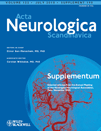Delirium in acute stroke – prevalence and risk factors
Conflicts of interest : none.
Abstract
Dahl MH, Rønning OM, Thommessen B. Delirium in acute stroke – prevalence and risk factors. Acta Neurol Scand: 2010: 122 (Suppl. 190): 39–43. © 2010 John Wiley & Sons A/S.
Background – Delirium is frequently seen as a major complication among elderly stroke patients. Few studies have prospectively studied delirium as a complication of acute stroke. In these studies, the results are conflicting regarding risk factors and estimated prevalence. The aims of the present study are to assess the prevalence of delirium in patients with acute stroke treated in an acute Stroke Unit, identify characteristics of patients with delirium and important factors associated with the development of delirium.
Methods – We conducted a prospective study of patients with delirium and acute stroke consecutively admitted to a Stroke Unit. The diagnosis of delirium was based on Confusion Assessment Method (CAM). CAM is devised from DSM-III-R criteria based on the diagnosis of delirium, and is a simple test with high sensitivity and specificity.
Results – One hundred and seventy-eight patients with a diagnosis of stroke were eligible for the study. The prevalence of delirium in acute stroke in our study was 10% (18 of 178 patients). Patients with delirium had significantly longer length of stay in the Stroke Unit (12.3 vs 8.5 days, P < 0.004). Prestroke dementia [odds ratio (OR) 18.7], hemianopsia (OR 12.3), apraxia (OR 11.0), higher age (OR 5.5) and infection (UTI or pneumonia) (OR 4.9) during in-hospital stay were associated with increased risk of delirium.
Conclusion – One of 10 stroke patients had delirium. This is the lowest prevalence of delirium shown in acute stroke patients. In our study, all patients were treated in a Stroke Unit. A Stroke Unit like the Scandinavian model may be beneficial in preventing delirium.




